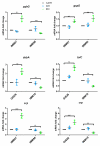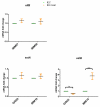Intestinal Epithelial Cells Modulate the Production of Enterotoxins by Porcine Enterotoxigenic E. coli Strains
- PMID: 35743033
- PMCID: PMC9223395
- DOI: 10.3390/ijms23126589
Intestinal Epithelial Cells Modulate the Production of Enterotoxins by Porcine Enterotoxigenic E. coli Strains
Abstract
Enterotoxigenic Escherichia coli (ETEC) strains are one of the most common etiological agents of diarrhea in both human and farm animals. In addition to encoding toxins that cause diarrhea, ETEC have evolved numerous strategies to interfere with host defenses. These strategies most likely depend on the sensing of host factors, such as molecules secreted by gut epithelial cells. The present study tested whether the exposure of ETEC to factors secreted by polarized IPEC-J2 cells resulted in transcriptional changes of ETEC-derived virulence factors. Following the addition of host-derived epithelial factors, genes encoding enterotoxins, secretion-system-associated proteins, and the key regulatory molecule cyclic AMP (cAMP) receptor protein (CRP) were substantially modulated, suggesting that ETEC recognize and respond to factors produced by gut epithelial cells. To determine whether these factors were heat sensitive, the IEC-conditioned medium was incubated at 56 °C for 30 min. In most ETEC strains, heat treatment of the IEC-conditioned medium resulted in a loss of transcriptional modulation. Taken together, these data suggest that secreted epithelial factors play a role in bacterial pathogenesis by modulating the transcription of genes encoding key ETEC virulence factors. Further research is warranted to identify these secreted epithelial factors and how ETEC sense these molecules to gain a competitive advantage in the early engagement of the gut epithelium.
Keywords: enterotoxigenic Escherichia coli; enterotoxins; gut epithelium.
Conflict of interest statement
The authors declare no competing interest.
Figures






Similar articles
-
Heat-labile enterotoxin enhances F4-producing enterotoxigenic E. coli adhesion to porcine intestinal epithelial cells by upregulating bacterial adhesins and STb enterotoxin.Vet Res. 2022 Oct 27;53(1):88. doi: 10.1186/s13567-022-01110-4. Vet Res. 2022. PMID: 36303242 Free PMC article.
-
Porcine Enterotoxigenic Escherichia coli Strains Differ in Their Capacity To Secrete Enterotoxins through Varying YghG Levels.Appl Environ Microbiol. 2020 Nov 24;86(24):e00523-20. doi: 10.1128/AEM.00523-20. Print 2020 Nov 24. Appl Environ Microbiol. 2020. PMID: 32561576 Free PMC article.
-
Enterotoxigenic E. coli virulence gene regulation in human infections.Proc Natl Acad Sci U S A. 2018 Sep 18;115(38):E8968-E8976. doi: 10.1073/pnas.1808982115. Epub 2018 Aug 20. Proc Natl Acad Sci U S A. 2018. PMID: 30126994 Free PMC article. Clinical Trial.
-
Pig vaccination strategies based on enterotoxigenic Escherichia coli toxins.Braz J Microbiol. 2021 Dec;52(4):2499-2509. doi: 10.1007/s42770-021-00567-3. Epub 2021 Jul 10. Braz J Microbiol. 2021. PMID: 34244980 Free PMC article. Review.
-
Heat-Stable Enterotoxins of Enterotoxigenic Escherichia coli and Their Impact on Host Immunity.Toxins (Basel). 2019 Jan 8;11(1):24. doi: 10.3390/toxins11010024. Toxins (Basel). 2019. PMID: 30626031 Free PMC article. Review.
Cited by
-
Heat-labile enterotoxin enhances F4-producing enterotoxigenic E. coli adhesion to porcine intestinal epithelial cells by upregulating bacterial adhesins and STb enterotoxin.Vet Res. 2022 Oct 27;53(1):88. doi: 10.1186/s13567-022-01110-4. Vet Res. 2022. PMID: 36303242 Free PMC article.
References
-
- Kotloff K.L., Nataro J.P., Blackwelder W.C., Nasrin D., Farag T.H., Panchalingam S., Wu Y., Sow S.O., Sur D., Breiman R.F., et al. Burden and aetiology of diarrhoeal disease in infants and young children in developing countries (the Global Enteric Multicenter Study, GEMS): A prospective, case-control study. Lancet. 2013;382:209–222. doi: 10.1016/S0140-6736(13)60844-2. - DOI - PubMed
-
- Khalil I.A., Troeger C., Blacker B.F., Rao P.C., Brown A., Atherly D.E., Brewer T.G., Engmann C.M., Houpt E.R., Kang G., et al. Morbidity and mortality due to shigella and enterotoxigenic Escherichia coli diarrhoea: The Global Burden of Disease Study 1990–2016. Lancet Infect. Dis. 2018;18:1229–1240. doi: 10.1016/S1473-3099(18)30475-4. - DOI - PMC - PubMed
-
- Kumar P., Kuhlmann F.M., Chakraborty S., Bourgeois A.L., Foulke-Abel J., Tumala B., Vickers T.J., Sack D.A., DeNearing B., Harro C.D., et al. Enterotoxigenic Escherichia coli–blood group A interactions intensify diarrheal severity. J. Clin. Investig. 2018;128:3298–3311. doi: 10.1172/JCI97659. - DOI - PMC - PubMed
MeSH terms
Substances
LinkOut - more resources
Full Text Sources
Medical
Research Materials
Miscellaneous

